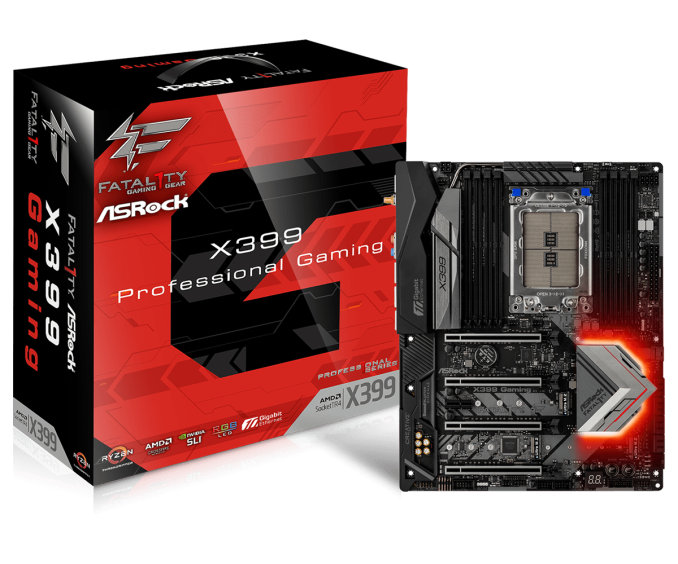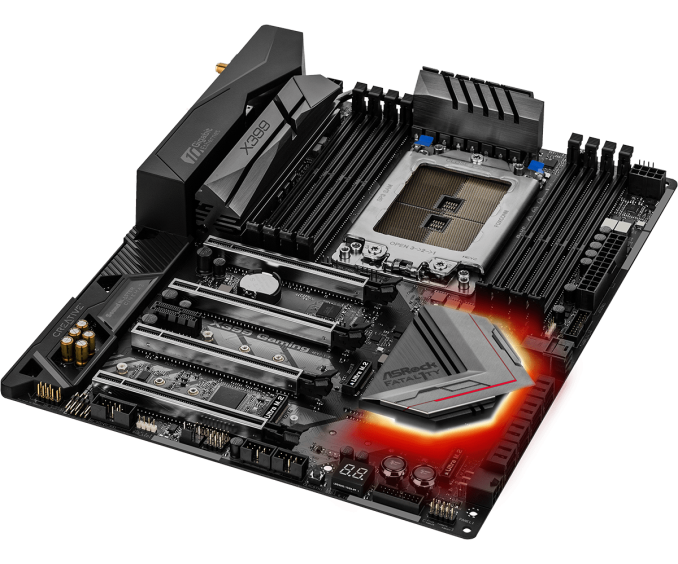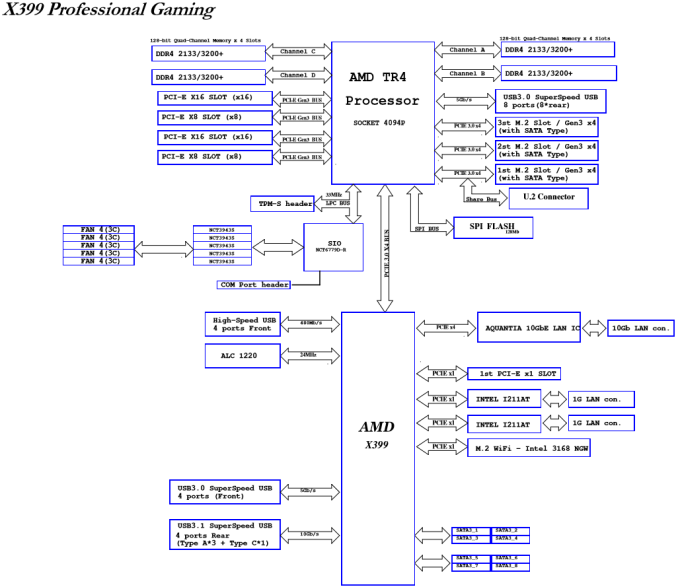An AMD Threadripper X399 Motherboard Overview: A Quick Look at Seven Products
by Ian Cutress & Joe Shields on September 15, 2017 9:00 AM ESTASRock
No stranger to the fray, ASRock is ready with the launch of two boards, the X399 Professional Gaming and X399 Taichi. Both boards share features but have enough differences to separate them in the product stack. The Pro Gaming adds 10 Gigabit Ethernet to its two Gigabit NICs and supports Creative Sound Blaster Cinema 3, while the Taichi aims to be a more mid-range board, by sticking with dual Gigabit NICs and uses Purity Sound 4. The styling is a little different too.
ASRock X399 Professional Gaming
The high-end board from ASRock will be the Professional Gaming. It also carries the Fatal1ty name, due to ASRock’s never-ending association with a pro-gamer from the turn of the century.
On the aesthetic side, the X399 Professional Gaming has a black PCB accented with gray heatsinks and grey stenciling where the M.2 slots are located. The memory slots are black, along with the rear IO cover that extends down the board. There are two heatsinks to cool the VRMs, connected by a heatpipe, and one reaches near to the rear IO. The chipset heatsink is not connected as part of the VRM cooling, but consumes a fairly large portion of the board and looks a bit like a play button. As with the fascination with RGB, the Professional Gaming has a few under the chipset heatsink. Users can add more RGB LEDs via two headers, and control them all through ASRock's RGB LED application.
The Professional Gaming has support for both NVIDIA 4-Way SLI and AMD 4-Way Crossfire with full-length PCIe slots. These have additional reinforcement to prevent sag or bending due to heavy PCIe cards during transit – the reinforcement is what ASRock calls its ‘Steel Armor’. The PCIe slots give an x16/x8/x16/x8 configuration from top to bottom, using 48 of the 60 PCIe lanes from the processor. The rest of the lanes are allocated to storage: there are a total of three M.2 PCIe 3.0 x4 slots, one of which is shared/switched with a U.2 connector. For other storage, there are eight SATA ports from the chipset that natively support RAID 0/1/10.
For added features, the X399 Professional Gaming jumps past the ever-present Gigabit Ethernet and uses an Aquantia AQC107 10 Gigabit LAN controller to appeal to users that want to invest in 10GbE. This is paired with two Intel I211AT network controllers, and all three can do regular gigabit Ethernet duties. If three Ethernet ports were not enough, also included is an integrated Intel AC8265 2x2 802.11a/b/g/n/ac WiFi module, to handle wireless duties.
ASRock provided chipset diagram for the Pro Gaming to show how it breaks down all the bandwidth:
For power delivery, ASRock uses a digital 11 phase International Rectifier solution, along with IR DrMOS for monitoring VRM current and temperature. Distributing power to the VRMs are two EPS 12V connectors, an 8-pin and a 4-pin, although the system will work with only the 8-pin installed. Typically we see EPS connectors oriented close to each other at the top of the motherboard, but here the connectors are located on opposite sides of the socket. As shown above, the 8-pin is in the upper right-hand corner above the DIMM slots, while the supplemental 4-pin is in the more familiar location at the top left-hand corner. ASRock asserts this creates a wider trace for the CPU VRM, bringing better power delivery efficiency and lowering temperatures.
For USB connectivity, the Professional Gaming has three USB 3.1 (10 Gbps) Type-A ports on the rear, one USB 3.1 (10 Gbps) Type-C port on the rear, two USB 3.1 (5 Gbps) headers for front panel ports, and two USB 2.0 headers for front panel ports.
| Fatal1ty X399 Professional Gaming | |
| Warranty Period | 3 Years |
| Product Page | Link |
| Price | $439.99 |
| Size | ATX |
| CPU Interface | TR4 |
| Chipset | AMD X399 |
| Memory Slots (DDR4) | Eight DDR4 Slots, up to 3600 MT/s Supporting 128GB Quad Channel |
| Network Connectivity | 1 x Aquantia AQC107 10 Gigabit LAN 2 x Intel I211AT GbE |
| Wireless Network | 802.11 ab/g/n/ac Dual-Band (2.4/5 GHz) Bluetooth 4.2 |
| Onboard Audio | Realtek ALC1220 |
| PCIe Slots | 4 x PCIe 3.0 (x16/x8/x16/x8) from CPU 2 x PCIe 2.0 x1 from Chipset |
| Onboard SATA | 8 x SATA 6 Gbps Supporting RAID 0/1/5/10 |
| Onboard SATA Express | None |
| Onboard M.2 | 3 x PCIe 3.0 x4 - NVMe or SATA |
| Onboard U.2 | 1 x PCIe 3.0 x4 (disables M2_1 when in use) |
| USB 3.1 | 1 x Type-A , 1 x Type-C (Rear Panel) |
| USB 3.0 | 8 x Rear Panel, 4 x via internal headers |
| USB 2.0 | 4 x via internal headers |
| Power Connectors | 1 x 24-pin ATX 1 x 8-pin CPU 1 x 4-pin CPU |
| Fan Headers | 1 x CPU 1A/12W Max. (4-pin) 1 x CPU Opt/Water Pump 1.5A/18W Max. (4-pin) 2 x Chassis (4-pin) 1 x Chassis Opt/Water Pump 1.(4-pin) |
| IO Panel | 2 x Antenna Ports 1 x PS/2 Mouse/Keyboard Port 1 x Optical SPDIF Out Port 1 x USB 3.1 Type-A Port (10 Gb/s) 1 x USB 3.1 Type-C Port (10 Gb/s) 8 x USB 3.0 Ports 4 x USB 3.0 Ports 3 x RJ-45 LAN Ports w/ LED 1 x BIOS Flashback Switch HD Audio Jacks |
















99 Comments
View All Comments
mapesdhs - Tuesday, September 19, 2017 - link
According to page 34 of the mbd manual, the main slots are wired x16/x8/x16/x8.msroadkill612 - Saturday, September 23, 2017 - link
Alternately put, no TR allows 3x 16x slots I think.markmi - Wednesday, September 20, 2017 - link
Context: X399 AORUS Gaming 7(rev. 1.0)I asked GIGABYTE about the ECC mode handling for this
board and they reported:
"It can support ECC memory by default in ECC mode."
So the table in the article that says "operates in non-ECC mode"
for this board is wrong on the issue as far as I can tell.
ntsarb - Saturday, September 23, 2017 - link
I'm waiting for a 6+1 PCIe 3.0 x16 slots, x399 motherboard, with 3x PLX switches to allow for 6x GPUs, for a rendering workstation. The ASRock X99 WS-E and the Asus X99 WS-E are no longer available in the market.karatekid430 - Thursday, October 26, 2017 - link
Quote from article:"Thunderbolt 3 certification requires a few things from the CPU side like graphical output which we haven't been able to do. We expect this will be developed upon through Raven Ridge and possibly get more groundwork down to activate TB3 on the X399 Designare EX."
End quote from article.
Then how do Intel Skylake-X with X299 motherboard have Thunderbolt 3 certification, when Skylake-X has no integrated graphics?
Hence why the quoted statement sounds fishy to me.
Cooe - Thursday, April 4, 2019 - link
*facepalm* Because Thunderbolt was developed, and is owned by Intel. They can license whatever they want to be Thunderbolt capable, because they literally created it, and set the standard for what is & isn't. Intel hasn't actually opened up Thunderbolt licensing & certification for non-Intel platforms yet like they promised though, so Gigabyte can't do anything about anything until they do & let AMD CPU's be TB3 capable.Techmister - Saturday, February 17, 2018 - link
MOtherboards need to be powerful no doubt in that. What attracted me towards The ASUS Strix X399-E Gaming is that it has an system which is automated to facilitate a five way optimisation http://www.printspoolerservices.com/printer-issues...">How to fix printer spooler error